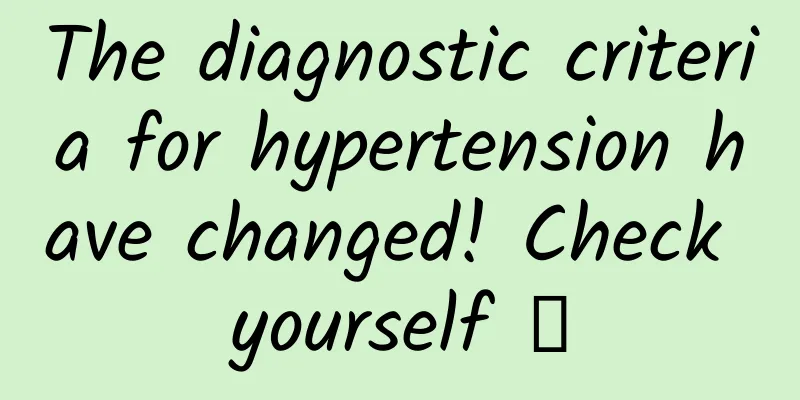The diagnostic criteria for hypertension have changed! Check yourself →

|
On November 13, the "Chinese Hypertension Clinical Practice Guidelines" (hereinafter referred to as the "Guidelines"), jointly formulated by the National Center for Cardiovascular Disease, the Chinese Medical Association, the Chinese Medical Association's Cardiovascular Disease Branch and other academic institutions, was officially promulgated. It is worth noting that the new "Guidelines" lowered the diagnostic criteria for hypertension from 140/90 mmHg to 130/80 mmHg. The adjustment of the standard may cause a surge in the number of hypertension patients in my country. Many netizens said: I became hypertensive unexpectedly... Copyright image, no permission to reprint Why should the diagnostic criteria for hypertension be adjusted? Professor Cheng Xiang, director of the Department of Cardiology at the Union Hospital of Huazhong University of Science and Technology, and Associate Professor Su Guanhua introduced that people with blood pressure between "130/80 mmHg and 140/90 mmHg" are called "prehypertension" people. New research has found that most of these people who have not been diagnosed with hypertension in the past have not received timely intervention, and therefore have a potential risk of cardiovascular and cerebrovascular diseases. At the online launch of the "Guidelines", Professor Zhao Dong of Beijing Anzhen Hospital introduced that the revision of the standards is not only supported by sufficient international and domestic evidence-based medicine, but also that people with blood pressure levels of 130-139 mmHg and/or 80-89 mmHg are mostly middle-aged and young people. Lowering the diagnostic standards reflects the concept of moving the line of defense forward and strengthening initial prevention. Otherwise, the critical opportunity to reduce the harm of cardiovascular disease and other diseases caused by hypertension will be missed. Guo Yifang, an expert in the drafting group of the Guidelines and vice president of Hebei Provincial People's Hospital, said in an interview with reporters that lowering the diagnostic criteria for hypertension can allow more people to pay attention to their blood pressure at an earlier stage and reduce blood pressure, which can significantly reduce the occurrence of cardiovascular and cerebrovascular complications. In this way, after 5-10 years, the reduction of cardiovascular and cerebrovascular diseases can save a lot of medical expenses, and the economic cost of taking medicine for a small number of people will be far less than these medical expenses. From the perspective of pharmacoeconomics, this adjustment is cost-effective. The number of young and middle-aged patients may increase. How to treat them? China is a country with a large number of people with hypertension. According to statistics from the health department in 2022, the number of people with hypertension in China has reached 245 million. Residents over the age of 18 suffer from hypertension, accounting for 27.9%. From the cause of the disease, hypertension has a certain hereditary nature, and many hypertensive patients have a family history of the disease, which belongs to primary hypertension . However, a larger proportion of the disease is caused by the combined effects of genetics, environment, lifestyle and other factors, which belongs to secondary hypertension. Copyright image, no permission to reprint Hu Dayi, chief physician of the Department of Cardiology at Peking University People's Hospital, said that currently, there are many young patients with hypertension in China, and the unhealthy lifestyles associated with this include lack of exercise, heavy drinking, unhealthy diet, obesity, etc. Negative emotions and mental illnesses such as anxiety and depression can also cause blood pressure to fluctuate greatly. In this case, the unstable blood pressure cannot be solved by taking antihypertensive drugs alone, and it is also necessary to "cure the root cause" by regulating emotions. Hu Dayi believes that more young and middle-aged patients may be diagnosed after the implementation of the new standard. He emphasized that for young and middle-aged hypertensive patients with blood pressure values between 130/80 mmHg and 140/90 mmHg , it is not necessary to take medication immediately, but to adopt the five prescriptions for effective control of hypertension, namely medication prescription, exercise prescription, nutrition prescription, mental, psychological, sleep prescription, and smoking cessation and alcohol restriction prescription. Guo Yifang also pointed out that the number of patients with hypertension has increased, but only 22% of the population needs medication. Most people do not need to take medicine, and their blood pressure can be restored to the ideal range through active lifestyle interventions, such as controlling diet, losing weight and gaining muscle, eating less salt, quitting smoking and drinking, etc. How to measure blood pressure yourself? The new "Guidelines" teach you how to measure blood pressure: 1. Measure blood pressure once in the morning and evening every day; 2. Take at least 2 blood pressure readings in a row for each measurement, with an interval of 1 to 2 minutes between each reading, and take the average of the 2 readings. If the difference between the first and second blood pressure readings is greater than 10 mmHg, it is recommended to measure a third time and take the average of the last two readings; 3. Avoid strenuous exercise, drinking alcohol, drinking caffeinated beverages and smoking 30 minutes before measuring blood pressure; rest quietly for 3 to 5 minutes before each measurement. 4. Measurement period: Morning: Measure before taking medicine, before breakfast, and after urination. Evening: before dinner. If you miss it, measure within 1 hour before going to bed. If you take medicine at night, it is recommended to measure before taking the medicine. 5. Patients with first visit or uncontrolled blood pressure: For patients with new diagnosis or whose blood pressure is not stably controlled, blood pressure should be measured continuously for at least 3 days a week. 6. For those with well-controlled blood pressure: measure blood pressure 1 to 2 days a week. Source: Science and Technology Daily, 21st Century Business Herald, People's Daily Health Client, National Business Daily, Yangtze River Daily |
<<: How to eat an anti-inflammatory diet? This dietary pattern is recommended
>>: Can minerals and rocks also be turned into "popcorn"?
Recommend
Xiao Fei Da Xia Training Camp Episode 9 Baidu Cloud Download
Resource introduction of the ninth phase of the L...
[New Generation of Traders] The second episode of the real-time video of the logic of the trader Jenny's circle
[New Generation of Traders] The second issue of t...
Why is Pokemon GO so popular? Please don't think with your butt!
The title is a bit vulgar. The origin of this is ...
iPhone iPad productivity boost! Let's play with Safari extensions
Many people try to use iOS devices (including iPa...
You have definitely never seen a “penguin with long legs”!
The Palace Museum published the "Illustrated...
Will a full circle of "snakes around the waist" be fatal? Four groups of people are susceptible, it's not too late to see now
Author: Wang Fang and Li Zhen, Chief Physician of...
Tips for shooting and attracting traffic with short videos!
A few days ago, when a business friend was chatti...
User operation: build a typical user growth model!
When a product enters its mature stage, its opera...
3 templates for high-conversion promotion ideas!
How to write a stunning opening for your creative...
Offline promotion tips: sharing from Alibaba, Beaver Home, and Wheat Commune
This article comes from the second session of the...
Renault, Nissan and Mitsubishi to share electric vehicle technology
Recently, foreign media reported that Nissan Moto...
Singing light bulb Sengled Pulse Flex music smart light review
With the increasing popularity of the Internet of...
Zhihu Live Product Analysis
2016 is known as the first year of knowledge paym...
As high temperatures approach, be alert to these 8 summer diseases!
On June 15, the Central Meteorological Observator...
Quickly improve your emotional intelligence and make her fall in love with chatting with you
Quickly improve your emotional intelligence and m...









